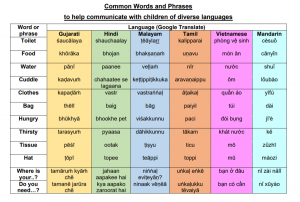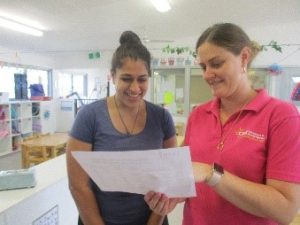27 Common words and phrases in community languages
Shauna Hart


Rationale
Instructions
The digital resource provides an easy to read chart with a range of languages from diverse Australian cultures. Educators would determine which language would be helpful to the children in their care and enlist the assistance from parents or the community to ensure the word and pronunciation are correct.
Educators can utilise this resource when children are new to the service to be able to communicate to them regarding their needs. This bank of words can continue to be used by carers to educate and celebrate diversity within the early childhood setting (Radich & Goodwin, n.d.).
Rationale
This resource is beneficial for educators, and families with children who have English as an additional language or dialect (EAL/D). By enlisting help from parents or the wider community it allows educators to effectively communicate with children and families when adjusting to the early childhood setting. It is reflective of the relationships between children’s micro and meso-systems of the Bioecological Model as the educators are using the knowledge of others to assist with meeting the needs of children in their care (USQ, 2019b). It also holds strong the child’s right to use his or her own language and enjoy their own culture (United Nations General Assembly, 1989).
Adjusting to a new setting can be emotionally and mentally challenging and children may become anxious, shy or withdrawn within the early childhood setting, however educators can assist children and their families to feel more comfortable by incorporating home languages (USQ, 2019c). Having a bank of words or phrases available to use, educators can assist children with daily routines and experiences when adjusting to the cultural contact of a new environment (USQ, 2019c). Through the ongoing use these familiar words, educators can continue to build respect and celebrate diversity with all children in their services, as they share the cultural and language aspects of their heritage (Radich & Goodwin, n.d.).
Links
Early Years Learning Framework (Department of Education, Employment and Workplace Relations [DEEWR], 2009):
- Outcome 1: children have a strong sense of identity
- Children feel safe, secure, and supported: communicate their needs for comfort and assistance
- Outcome 2: children are connected with and contribute to their world:
- children respond to diversity with respect: educators expose children to different languages and dialects and encourage appreciation of linguistic diversity
National Quality Standards (NQS) (ACECQA, 2020c):
- Standard 5.1 Respectful and equitable relationships are maintained with each child.
- Element 5.1.1: Responsive and meaningful interactions build trusting relationships which engage and support each child to feel secure, confident and included.

